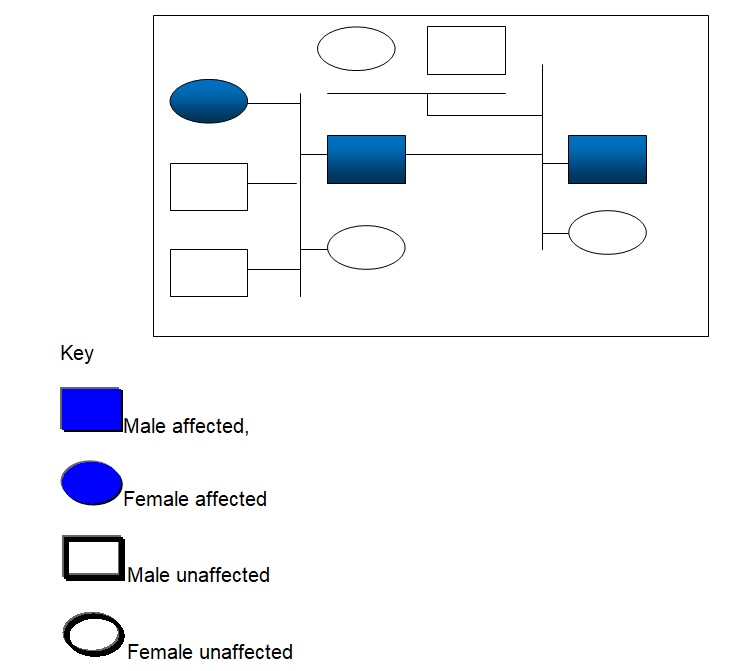Introduction
The pedigree problem is generally featured with the necessity to provide the correct connections among the family members in a genetic history chart. A pedigree tracks the inheritance forms of genetic traits in a family’s generations (Kramvis, Kew, & Francois, 2005). A pedigree traces the lineage through which a genetic condition can be traced by doctors through documenting biological relationships in a family of a patient who is suffering from a hereditary disease. Mendel’s law of inheritance may not apply fully to all humans genetic conditions as a pedigree chart shows.
Some genes are inherited but do not follow the Mendel law of genotypes transfer as outlined below (Kramvis, Kew, & Francois, 2005). A genotype is said to be a homozygous when two alleles in the diploid or identical e.g AA or aa. Homozygous prototype produces only one type of gamete. Individuals that are homozygous are said to be pure line or true breading. A heterozygous genotype is one that carries different alleles e.g. Aa. Different types of gametes are produced by a heterozygote. Taking a sample of some me of the immediate relatives of a woman (9 in total.) a pedigree is drawn as shown below. Paternal grandfather is affected while paternal grandmother is not affected as they form generation I. The following generation has seven individuals that include 2 paternal uncles and an aunt. One of the uncles is married to an unaffected aunt. At generation III, 9 individuals form the generation III where the subject comes from. At this generation we have 2 females who are free from the Achondroplasia attack while 2 females are affected. 2 males at this generation are affected by the disease while 3 of them are not affected at all.
Main body
Sex cells are often referred to as gametes whereas alternative forms of a gene are termed as alleles. Whenever one pair of alleles can come to a phenotypic expression only in homozygous genotype, we call those alleles recessive. An allele that expresses itself in the heterozygote as well as in homozygote condition is a dominant allele. A measurable characteristic or distinctive trait is called a phenotype as show on the pedigree chart.

- Subject: affected woman
- Subject’s two brothers, unaffected
- Subject’s father affected, mother unaffected
- Subject’s paternal aunt and uncle, unaffected
- Subject’s paternal grandfather affected, grandmother unaffected
Autosomal dominant affection in the pedigree may be observed if the heterozygote has a reduced number of functional low density lipoprotein receptors. Hence, the affection in the family may be observed in every parent.
Autosomal recessive inheritance means that both genes are defected. Hence, both parents should be affected for making their children affected with the decease. In general, this may be observed in families where affected, while only one person is affected among the grandparents. (Acheson and Wiesner, 2004)
Sex-linked dominance is not observed, as both sexes in this family are affected. The rules of sex-linked dominance presuppose that x-chromosome is defected and involved into decease transmission. Recessive transformation is observed when both genes are abnormal. If only one gene is abnormal, the affection will not be observed.
Y-linked inheritance presupposes that the damaged Y-chromosome is transmitted from father to son, and does not affect the female representatives of a family. Hence, the most probable model that is observed within this family is autosomal dominant, as recessive models may observed only if two parents are affected, and sex linkage is not mentioned in the pedigree chart.
Conclusion
It should be noted that considering the given pedigree data, Achondroplasia genetic disorder is a dominant autosomal phenotype. Despite the fact that the subject’s brothers are unaffected, the case deals with autosomal inheritance which is not X-linked. In other words, the phenotypic expression of this kind of dwarfism is not related to the individual’s sex, and the trait can be regarded an autosomal one. Though it was only the subject’s father who was affected in the II generation, while the paternal aunt and uncle were unaffected, if the chromosome had been X-linked, the subject woman had to inherit it from parents who are both affected. Due to the fact that her mother was unaffected and the genetic disorder was inherited, it can be stated that the inherited disease was not X-linked. In the pedigree there were no cases when an affected child was born from unaffected parents, in all cases at least one of parents was affected. This means that this disease is autosomal dominant not the autosomal recessive one which can be inherited in case if one of the parents is a carrier of the trait.
Achondroplasia genetic disorder follows an autosomal dominant mode which resulted in the subject’s inheritance of the trait. The analysis of the whole pedigree was helpful for identifying the inheritance mode, while the results of the analysis of a single generation representatives could be controversial and confusing.
Reference List
Acheson, L.S.,& Wiesner, G.L.(2004).Current and future applications of genetics in primary care medicine. Primary Care,3, 449-60.
Kramvis A., Kew, M.,& Francois, G. (2005).Hepatitis B virus genotypes.Vaccine, 23, 2409-2423.